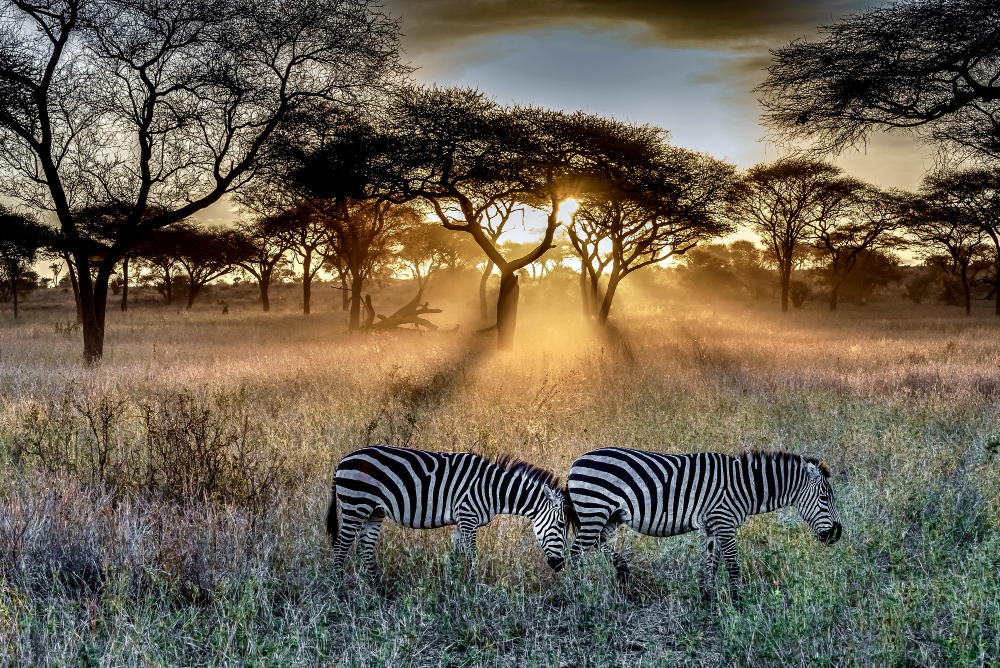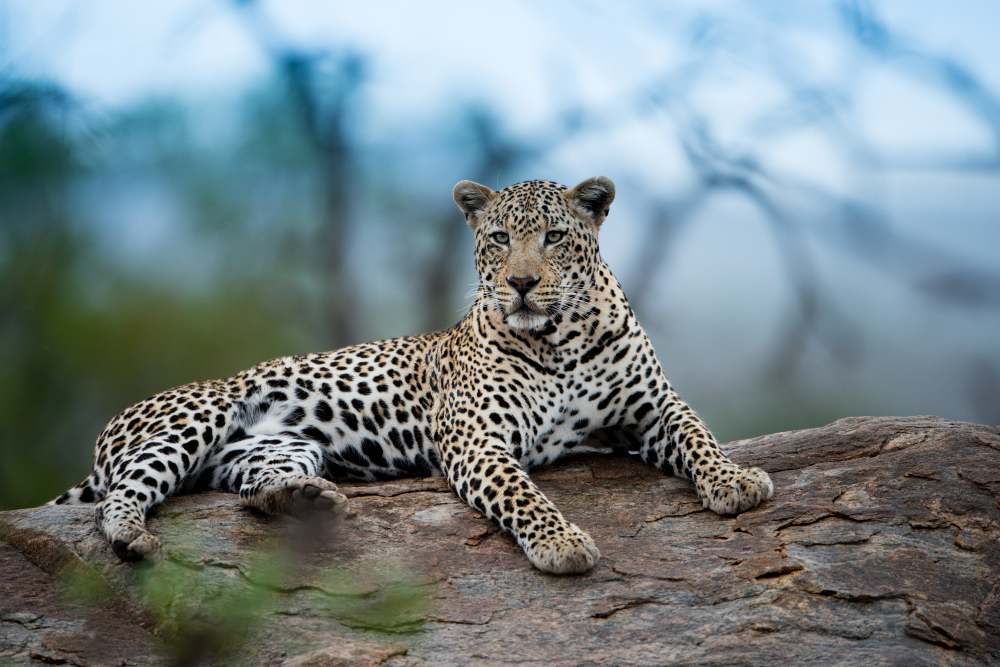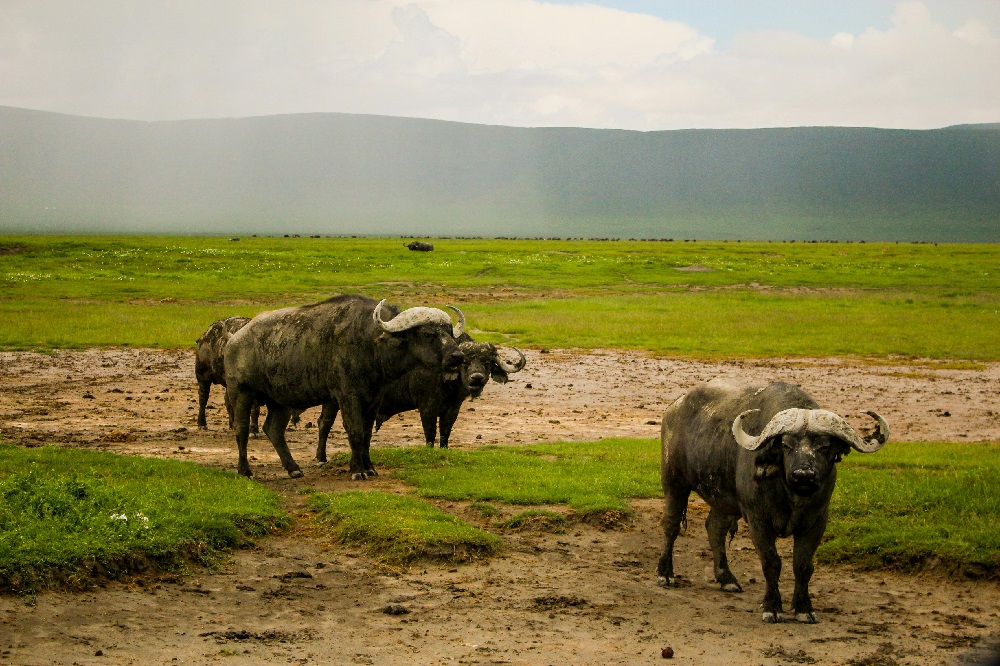Ngorongoro Crater
Ngorongoro Crater, which was once a massive volcano much bigger than Kilimanjaro, is today a mystical Eden that is home to millions of creatures.
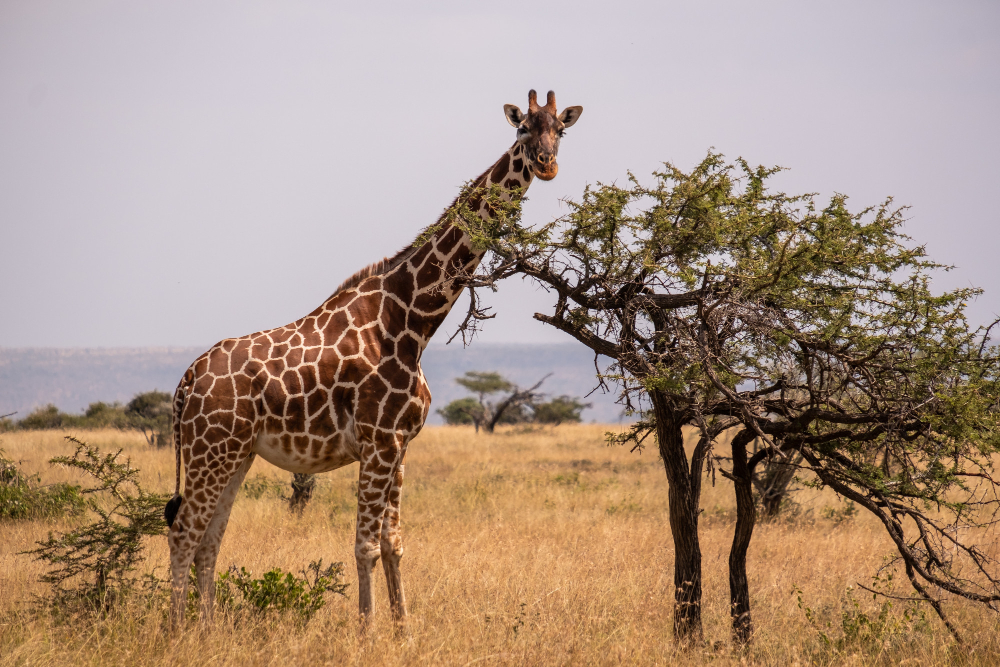
Encircling a large crater floor are intact forest-coated crater walls that can reach heights of 600 meters, making this location one of the world’s most distinctive safari sites.
Where is Ngorongoro found?
Ngorongoro Crater is located in Tanzania’s north Great Rift Valley, west of Arusha. Because the Ngorongoro Crater is so close to both the Serengeti and Lake Manyara National Park, visits there are frequently coupled with visits to these two locations.
Size of Ngorongoro Crater
The Ngorongoro Crater’s bottom is up to 12 miles in diameter and roughly 102 square miles. Although this seems like a lot, the larger Ngorongoro Conservation Area in the Great Rift Valley spans an enormous 3,200 sq km.
What Makes Ngorongoro Special
The crater walls, which are currently 610 meters high, separates the caldera from the Ngorongoro Conservation Area. Because they have nowhere else to go, the crater wildlife stays concentrated there year-round, providing excellent chances for animal encounters.
Because of the variety of habitats found here, you can witness an astounding array of species in a comparatively short area. Take pictures of flamingos in the soda lake, look for hippos in the marshes, and spot animals on the grassland plains. Because of the amazing wildlife abundance in the crater, sightings are considerably easier here.
Ngorongoro Crater was Formation
About 2.5 million years ago, a massive volcanic outburst created the Ngorongoro Crater. Many people think the volcano will be as large as Mount Kilimanjaro. The large, intact caldera that is seen today was formed by the peak’s inward collapse.
The rich and fertile soils here are a result of the eruption’s ash covering the surrounding area. The multitudes of creatures that currently inhabit the Ngorongoro Crater are supported by this old underlying ecology.
Wildlife in Ngorongoro Crater
On the crater floor, one can observe wildebeest, zebras, elands, Thomson’s and Grant’s gazelles, and Cape buffalos.You can also see a lot of waterbucks, elands, warthogs, wildebeests and hartebeests. The crater is home to roughly 300 elephants, including about 75 large tuskers, and 30 black rhinos. Additionally, you will find multiple groups of hippos lounging in the freshwater ponds and wetlands. Additionally, keep a lookout for baboons, African civets, and vervet monkeys.
Because of the abundance of prey, predators are common here. This area is home to more than 60 lions, 6,000 spotted hyenas, jackals, golden wolves, leopards, and cheetahs. Official statistics are unknown for the latter two, which are more elusive.
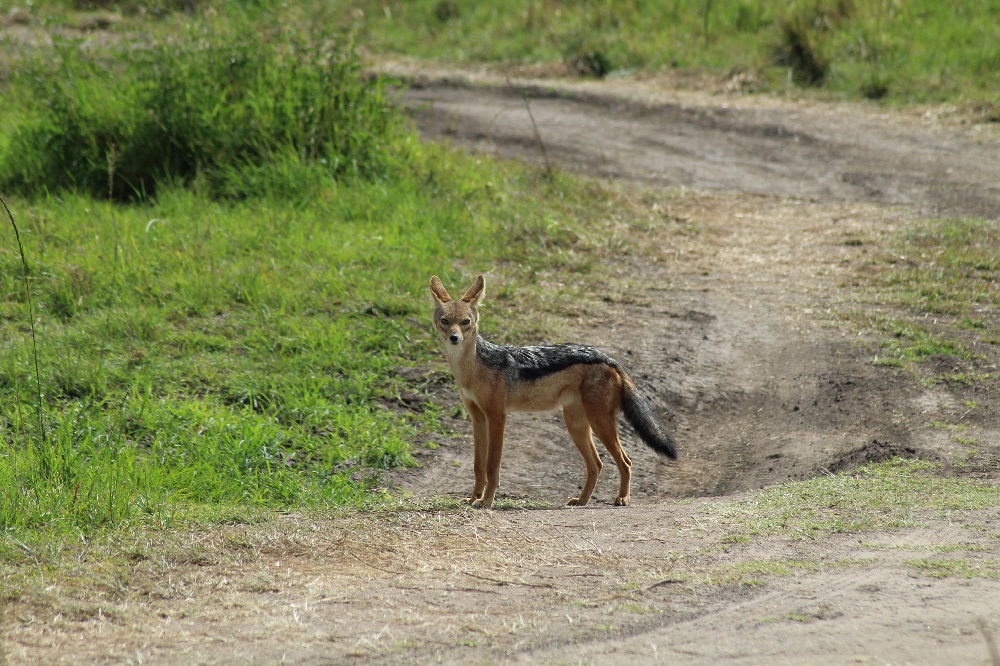
More than 500 species of birds can be found in the rim forests and the crater, making for a diverse and abundant birdlife. Flamingos, ostriches, secretary birds, Kori bustards, Fischer’s lovebirds, and augur buzzards are among the most often sighted birds.
Main Animals in Ngorongoro Crater
The other dominating animal in the Ngorongoro Crater is the lion. The primary reason so many tourists pick this area for their safari is that it has one of the densest populations on the continent. For an exciting experience, you might even get to witness the lions hunting near your game vehicle.
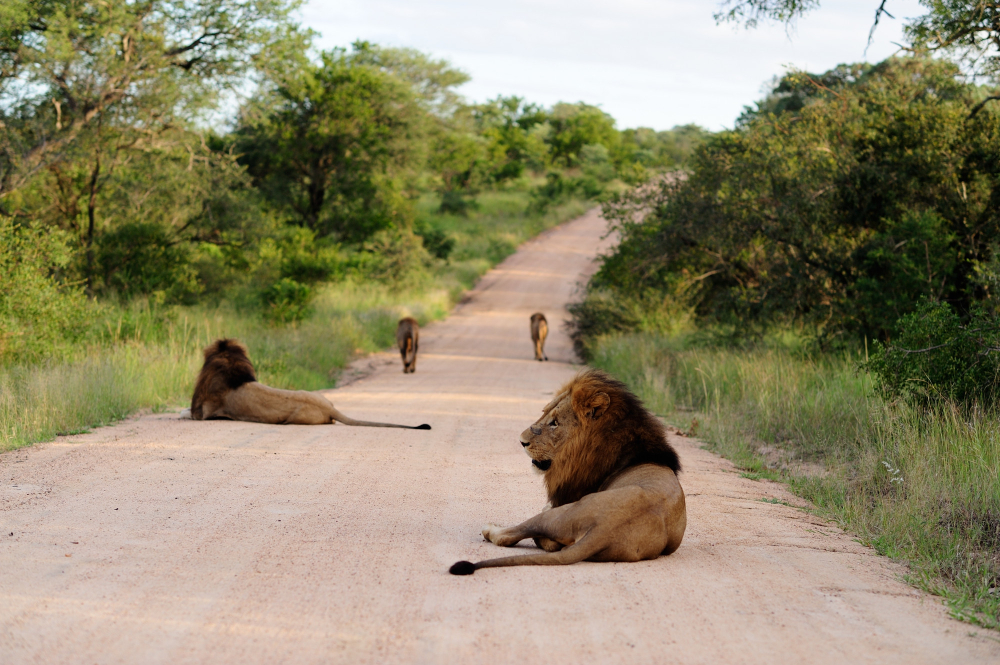
However, a lot of people travel to Ngorongoro Crater in the hopes of seeing a black rhino.
Rarest Animals in Ngorongoro Crater
Although they are extremely rare, you might be fortunate enough to spot the African golden cat and African wild dog while on safari in the Ngorongoro crater.
In the 1990s, it was believed that African wild dogs were extinct in the Serengeti as a whole. Nevertheless, a 2016 study confirmed their presence in the crater following a 30-year hiatus. We don’t know if they are still in the crater almost ten years later.
Due to its small size, this is one of the best sites in Africa to see black rhinos, even though they are also endangered.
The Black Rhinos
The Ngorongoro Crater is home to thousands of zebras, hyenas, and wildebeests, but only 30 black rhinos. The crater was home to about 100 black rhinos in the 1960s, but by the 1980s, poaching had drastically decreased that number.
The rhinos now find sanctuary in the crater. The population of black rhinos in this area is gradually growing as a result of the Tanzania National Parks Authority’s continuous conservation efforts. All of the animals have been equipped with tracking devices so that rangers can keep an eye on them, and they all reside in a protected section of the crater.
Black rhinos can be seen in the Ngorongoro Crater throughout the year. However, to improve your chances of seeing one, try to go between June and October, when it’s dry. The animals are more noticeable during this time due to the scant foliage, particularly when they congregate near the watering holes.
The Lerai Forest is where many black rhinos spend the night. They may emerge from the trees if you go on an early morning game drive. For the remainder of the day, they disperse throughout the plains.
Are There Big Five
The Ngorongoro Crater is home to the Big Five: buffalo, leopard, lion, rhino, and elephant of Tanzania’s most well-known reserves. At the top, just above the Serengeti, is Ngorongoro Crater, which is home to 21 lions per 100 km².
Do Animals Leave The Crater
Although animals can physically leave the Ngorongoro Crater, the majority stay here year-round. The animals find it impossible to leave due to the sheer cliffs, yet they are drawn in by the variety of habitats, supplies, and year-round water.
Wildlife can enter and exit the crater as necessary, thanks to a few openings along the rim.
Predator in Ngorongoro Crater
You may almost certainly spot big cats at the Ngorongoro Crater because it is of predators on the planet. Lions, spotted hyenas, cheetahs, golden wolves, and bat-eared fox are all here due to the plains game prey.
The encounter with an African golden wolf, a small wolf species found only in northern Africa and extending as far south as Tanzania’s Ngorongoro Crater and the Serengeti, was another unforgettable experience. Only Kenya and Northern Tanzania are home to the golden wolves, which are a subspecies known as the Serengeti wolf.
Are Crocodiles found in Ngorongoro?
The Ngorongoro Crater is not a suitable habitat for crocodiles, so you won’t find any there.
Are Snakes found in Ngorongoro?
The Ngorongoro Crater is home to snakes. Although they can be difficult to notice because they are so well disguised.
Birdwatching in Ngorongoro
With more than 500 species to observe, birdwatching in the crater is fantastic. The most visible animals during game drives include flamingos, ostriches, secretary birds, openbill storks, and hamerkops, but you can also see many of the smaller species.
Although there is a lot of birdlife in the crater all year round, November through April is the ideal time to visit for the widest variety of species. The migrating birds come at this time, showcasing their breeding plumage.
Wildlife Conservation in Ngorongoro Crater
The Ngorongoro Crater’s viability as a natural sanctuary depends on the preservation of its wildlife. Numerous organizations and nonprofits put up endless effort to preserve the environment and its inhabitants, guarding against poaching, invasive species, and conflicts between people and animals.
Threats to Ngorongoro Crater
The Ngorongoro Crater is seriously threatened from several angles, just like any other safari area. Conflict between people and wildlife is one of the primary problems. Livestock numbers increase in tandem with local population growth, resulting in overgrazing and the possible spread of illness to wild animals.
Wildlife corridors are cut off when settlements and infrastructure grow to accommodate the growing population, which reduces the amount of habitat space. Elephants are especially impacted since they move in search of food and water. Livestock can also be attacked by wild creatures like lions and leopards, which exacerbates conflicts between humans and the environment. Retaliation has also been known to occur.
Another issue in Ngorongoro is poaching, which is fueled in part by poverty and in part by greed. Black rhinos and elephants are particularly vulnerable to the illicit wildlife trade. There are initiatives in place to help counter the threat, including surveillance and 24-hour ranger patrol monitoring.
Life in the Ngorongoro Crater is also greatly impacted by climate change. Reduced wildlife populations, habitat destruction, and dwindling water supplies are all results of drought. All of Africa is experiencing a similar situation, one that is probably going to have a detrimental impact on both people and wildlife for a very long time.
Weather and Climate
There are two dry and two wet seasons in the temperate climate of the Ngorongoro Crater. The average afternoon temperature on the crater floor during the dry seasons is roughly 19°C. In contrast, days during the wet seasons are warmer, with an average temperature of roughly 23°C. Wrap up and wear a warm cap if your ears get chilly quickly, as mine do. The crater floor is frequently very windy.
There will be dry spells even if you travel during the rainy seasons because rain typically falls in brief, intense storms. This implies that if you’re prepared to be a little flexible with routes and schedules, you can still have a great safari.
Best Time to Visit Ngorongoro Crater
Although you can visit the Ngorongoro Crater at any time of year, there are a few factors to take into account before choosing the ideal time for you. Although there will always be animals to see, your experience may be impacted by the crowds and weather.
The lengthy dry season, which lasts from June to October, is when most tourists decide to go. This is the ideal time of year to visit Tanzania because of the temperate weather, little rain, and the dry plains, which make it easy to observe wildlife because animals gather in big groups near watering holes.
The fact that this is peak season, which means there will be more people and more expensive costs, is a drawback to these perfect circumstances.
Arrive in early June or January, or February during the brief dry season for fantastic weather and a little less crowding.
The two wet seasons are at the other extreme of the spectrum. The “short rains” take place from mid-October to December, while the “long rains” happen from March to May. They make driving more challenging by bringing muddy roads and warmer temperatures.
On the plus side, the vistas are brought to life by the lush flora, and there are significantly fewer tourists. Although seeing animals can be more difficult, it only makes the experience more satisfying. Don’t discount this season without taking into account its advantages, as birdwatching is at its peak from November to April.
Days to Spend in Ngorongoro Crater
What you hope to gain from the experience should be taken into account while choosing how long to stay in the crater. Depending on your interests, timetable, and financial constraints, you can reserve a single night or multiple days here.
To see everything the crater has to offer, one day is more than enough. Due in large part to the hefty admission fees, this is the most popular period to visit. The cost of a vehicle alone at Tanzania’s most costly safari site, Ngorongoro Crater, is $295 per day.
A thorough understanding of the distinctive caldera environment can be gained by driving along the main tracks during this time. It’s preferable to stay close to the crater if you plan to visit it in a single day, so you can maximize your time there by going on an early morning game drive.
Ngorongoro Safari Areas
-
Crater Floor
You will spend the majority of your time on game drives on the crater floor, which is located near the caldera’s base. The grassy plains that make up the majority of the landscapes here attract a lot of grazing species, including buffalo, gazelles, zebras, and wildebeest.
Because of the abundance of prey, predators like spotted hyenas and lions can be seen here. You may even be fortunate enough to witness a large cat hunt.
-
Lake Magadi
The soda lake in the middle of the crater floor is called Lake Magadi, or simply “Lake Magad.” Numerous animals, including hippos, who like to stay cool in the lake, may be found here, making it one of Ngorongoro’s main attractions.
The lake and nearby soda flats are home to thousands of lesser flamingos, who feast on the plentiful algae in the shallows. You may probably spot everything from storks to pelicans at the lake, which is one of the best places in the Ngorongoro Crater to observe birds.
-
Crater Walls
The Ngorongoro Crater is surrounded by steep, wooded walls that serve as a natural barrier, dividing the caldera from the larger conservation area. As you drive down to the crater floor, pay attention to the trees because the walls and rim are great leopard country, covered in rich montane forest.
To see the crater from a different angle, you can go on walking safaris along some of the rim. For your safety, a guide and an armed national park ranger accompany you on these excursions along Maasai pathways. Olive sunbirds, zebras, and monkeys are among the many species to be seen, and the vistas from this altitude are breathtaking.
Several lodges with stunning views of the Ngorongoro may be found high on the crater rim.
-
Swamp
In the Ngorongoro Crater, two seasonal marshes are great locations to see wildlife. Here, one can frequently spot waterbucks, lions, and elephants in addition to a variety of wading birds.
Gorigor Swamp is located near Lake Magadi, southeast of the crater. It’s one of the greatest spots to witness hippos, which you may observe while enjoying a picnic in the area. Here, black rhinos are also frequently sighted.
Mandusi Swamp rises high in the northwest of the crater, fed by the Munge stream. Predators are drawn to this location because it is a favorite grazing spot for zebras and wildebeest. Look out for the grey-crowned cranes who call these waters home.
Is Are Ngorongoro Safari Safe
The Ngorongoro Crater is a secure place to go on safari. Wild animals are present at any Tanzanian safari spot, but you’ll always be in good hands because you’ll be escorted by a knowledgeable local guide and occasionally an armed ranger.
Even though volcanic activity created the Ngorongoro Crater, the region’s volcanoes are largely extinct or inactive and are not seen as a serious hazard. Ol. Doinyo Lengai is the only active volcano in the area. Although there is continuous thermal activity there, the majority of eruptions are minor and do not affect local safaris. It is located north of the Ngorongoro Crater.
While standard measures should be taken, crime and theft are not major issues in the Ngorongoro region. Avoid going out after dark and don’t leave valuables on show.
Car accidents do occur, particularly in areas with rough terrain or high traffic volumes; therefore, road safety should be taken seriously. In the Ngorongoro Crater, you can drive yourself, but having a guide behind the wheel will make the experience much less stressful.
A lot of tourists will fly into northern Tanzania. Traveling by air always carries some danger, particularly for light aircraft, but safety is taken very carefully, and most visitors have no issues.
Travelers can get food poisoning anywhere , so it’s a good idea to be ready and aware of the warning signs. There will be bottled and filtered water available at your lodging because tap water is unsafe to consume.
You shouldn’t have any problems with the meals because the majority of lodges in the Ngorongoro Crater have strong hygiene standards. Freshly cooked produce is preferable to salads that might have been washed in water if you’re dining at more neighborhood eateries and wish to exercise caution.
Is Ngorongoro a Malaria Area
Because the Ngorongoro Crater is home to both mosquitoes and tsetse flies, care should be taken to prevent getting bitten. While tsetse flies can spread a parasite that occasionally causes African Sleeping Sickness, mosquito bites can cause malaria.
Wearing long-sleeved shirts and pants decreases the chance of getting bitten, especially around nightfall. The best colors are light or neutral. Apply insect repellent and sleep under a mosquito net at all times. Consult your healthcare practitioner about recommended vaccinations and anti-malarial drugs before you leave home.
Things to do in Ngorongoro Crater
-
Guided Safari
The best way to experience the caldera and its untamed inhabitants is to go on guided game drives around the crater bottom. After being picked up from your accommodation, you will be transported to the entrance gate of Ngorongoro Crater.
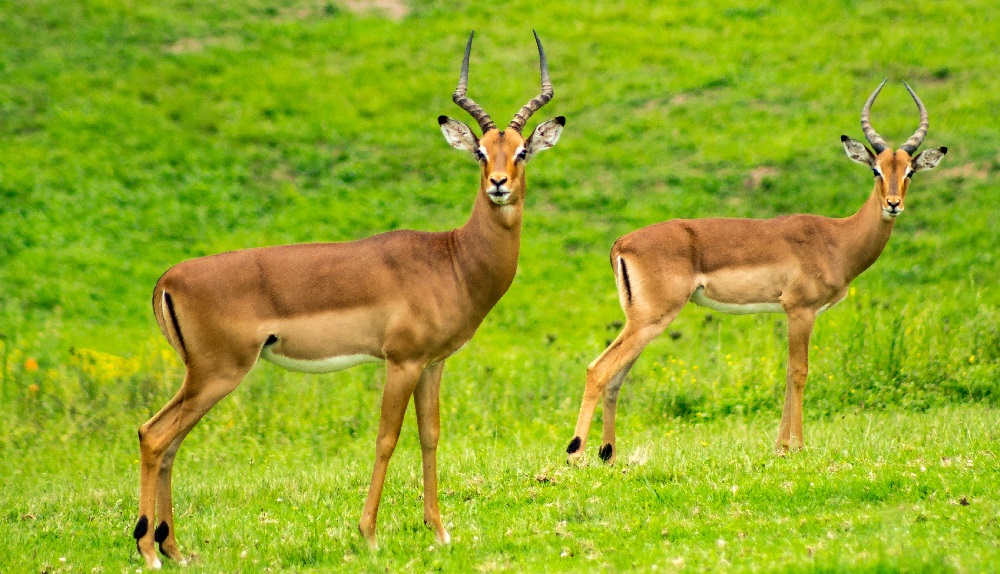
The majority of visitors then spend an entire day in the crater, searching for animals by exploring the lakes, forests, and grassland plains. Typically, you’ll bring a picnic lunch that you may eat while seeing the hippos.
-
Walking Safari
Majority lodges allow you to add a walking safari along the Ngorongoro Crater Rim to your schedule. A guide and an armed ranger will accompany you as you travel traditional Maasai pathways across the highlands.
Observing native plants and birds of the montane forest, such as the cinnamon-chested bee-eater, is are highlight. You might also come across larger animals like elephants or zebras. The expansive views over the crater are the highlight of these walks, and there are numerous photo ops.
-
Photography
One of the most well-liked destinations in Tanzania for a picture safari is the Ngorongoro Crater. First of all, choosing a subject is made simple by the abundance of animals; you won’t have to spend hours searching for your first animal.
Additionally, the backdrop is breathtaking, with the expansive caldera and sheer crater wall providing the ideal setting for your photographs. A little diversity is provided by the varied terrain, which includes savanna, soda lakes, swamps, and woodlands.
You will never take the same picture twice because the light varies throughout the day. To capture the wildlife as it awakens on the plains, choose an early morning game drive. For extra effect, try adding a little mist.
Olduvai Goerge
Perhaps Africa’s most well-known paleoanthropological site is Olduvai Gorge. Louis and Mary Leakey found the oldest bones of Homo sapiens here in 1959, supporting the idea that humans evolved from other animals.
More than 60 hominins and primitive stone tools that our distant ancestors previously used have been discovered among the other fossils buried in the volcanic rock here. When taken as a whole, these fossils offer an intriguing window into the evolution of humanity over the last two million years.
As part of your journey through the Ngorongoro Crater, you can visit the Olduvai Gorge.
Empakai Crater
It contains several volcanic calderas, including the Empakai Crater. The crater is one of the most beautiful places in the area because of its high rim and emerald soda lake.
Walking safaris are common here, either down in the gorge or along the rim. While the lush rainforest is home to elephants, leopards, monkeys, and a variety of birds, flamingos can be spotted along the lake’s coast. An armed ranger will accompany you on the trip to protect your safety.
Olmoti Crater
Located at the northern edge of the Ngorongoro Crater, this tiny crater provides an alternative viewpoint of this untamed volcanic terrain. It boasts some of the best views in the region and is Tanzania’s third-highest summit.
Admire breathtaking views of the Munge Waterfall and the Olmoti Crater rim after hiking through the jungle. Reaching the summit only takes roughly forty minutes, making it an excellent half-day activity.
How to Book a Ngorongoro Crater Safari Booking
It can be difficult to choose and reserve a Tanzania safari because there are so many game parks, hotels, camps, tour companies, and safari varieties, especially for first-time travelers.
However, there’s no need to worry; I’ll give you a summary of each of your four booking choices in this part, along with my personal preference.
Option 1: Self-Drive Safari
Visitors are permitted to drive around a few of Kenya’s national parks and wildlife reserves.
Self-driving safaris appear to be a fantastic way to save money and provide a great deal of flexibility. All you have to do is rent a car, purchase your park admission, and go exploring, right?
Sort of. Even though self-driving cars might seem like a fantastic idea, there are a few advantages and disadvantages to consider before making your choice.
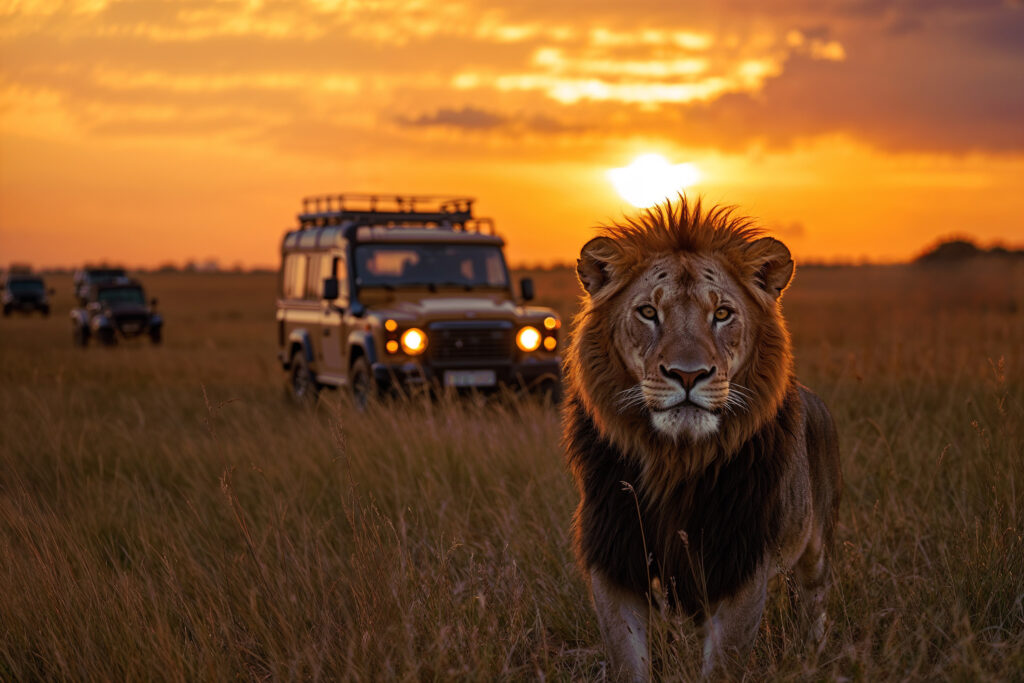
Your ability to identify animals is the first and most crucial item you should consider. There, be truthful with yourself.
When it comes to identifying animals, a local guide can be really helpful. You can find animals with the assistance of guides that you otherwise would not have seen. You have a far better chance of seeing specific animals since they have a network of other guides who can tell them where they are.
Your safari budget is the second thing to think about. On safari, driving yourself could seem like a terrific way to save money, but when you sum everything up, the savings are not as large as you might first believe.
In contrast, Tsavo costs $61 during the high season and $41 during the low season, whereas Amboseli charges $118 during the hot season and $94 during the low season. These costs are per person, per day, and inclusive of tax.
If you intend to visit several parks during your two-week Kenya safari (which I strongly recommend), these expenses quickly mount up.
Whether you have a safari reservation with a travel operator or are going on a self-drive safari, the costs are the same. When calculating the total cost of a self-drive safari, keep in mind that the park fees are typically included in the tour price offered by the majority of tour companies.
Logistics-wise, you’ll need to rent a 4×4. Gas and car rentals can get expensive. Along with being reasonably adept at navigation to avoid getting lost in the parks, you’ll also need to grasp the fundamentals of car maintenance in case you have any problems while on safari.
Option 2: Local Tour Operator
Booking through a local tour operator is, in my opinion, a no-brainer after attempting self-drive safaris and making reservations through both domestic and foreign agencies!
The people on the ground are local tour providers. With a local guide, you’ll see a lot more creatures than you would on your own, and the best ones are intimately familiar with the areas they work in and can handle even the slightest nuances!
Additionally, their cost is not significantly higher than that of a do-it-yourself self-drive safari. Except for your driver’s guide, prices are essentially the same.
However, depending on the local tour operator you choose, your safari experience can vary significantly, so it’s important to do your homework and make an informed decision.
To see what other people have experienced, I advise reading as many guest reviews as you can on Google and Tripadvisor. This is among the best methods to determine if you want to make a reservation with a particular supplier.
As an alternative, you may hire a seasoned travel planner like me to help you go through the various tour alternatives and select the one that’s ideal for you.
Option 3: International Travel Agents
Using an overseas travel agency is an additional choice if you’re not sure that making your reservation through a local operator is the best course of action.
These foreign agents will take care of any problems that come up before, during, and after your trip and can assist you in booking your complete safari from beginning to end.
All of this additional assistance, though, can have a price. In terms of dependability and customer service, making a reservation through an international travel agency can seem like the “safest” choice, but it’s crucial to understand that the majority of foreign tour operators are merely acting as middlemen on safari excursions.
International agents typically mark up the price and then sell it to you after working with local tour operators. The only significant variation is the cost of your safari; otherwise, the final experience is typically the same. So, if you’re on a tight budget, keep that in mind!
International tour operators have the advantage of typically being “bonded,” which theoretically protects your money if they fail before your trip.
Option 4: Fly-In Hotel Safaris
Fly-in safaris are an additional choice if you are time-constrained and have a large budget.
Using light planes, these upscale safaris take visitors throughout a region or nation. Even if you only have a little holiday, this enables you to see a huge area.
Additionally, since you won’t have to drive between parks, you’ll have more time to spend in each reserve. Following your flight, you will drive 4X4s around the parks, enjoying an experience akin to that of a typical driving safari. Be aware, though, that hotel game drives are usually not private, so you will have to share your car with other visitors and vie for the finest views.
For those who wish to pack as much as they can into their trip, fly-in safaris are a good choice. But it makes sense that they are among the priciest excursions available; the cost of the safari package is significantly increased by all those quick flights!
Why is it so Expensive?
Even though Ngorongoro Crater safaris are among the priciest in the nation, if money permits, it’s still worthwhile to go. The trip is worth every cent because of the breathtaking scenery and abundant wildlife, and you can be sure that your money is being used wisely.
In order to pay for ranger salaries, upkeep, and conservation, park fees are substantial. These are all essential to maintaining this significant habitat for many years to come. In order to minimize the impact of tourists on the crater and lessen park wear and tear, the number of visitors is restricted. Because larger locations can accommodate more people, fees are somewhat higher there.
Is Ngorongoro Crater Worth
Although it may cost more than some of Tanzania’s other safari locations, it is among the greatest spots on the continent for a wildlife vacation because of the amazing scenery and variety of species. It’s a special place that is unlike any other place.

